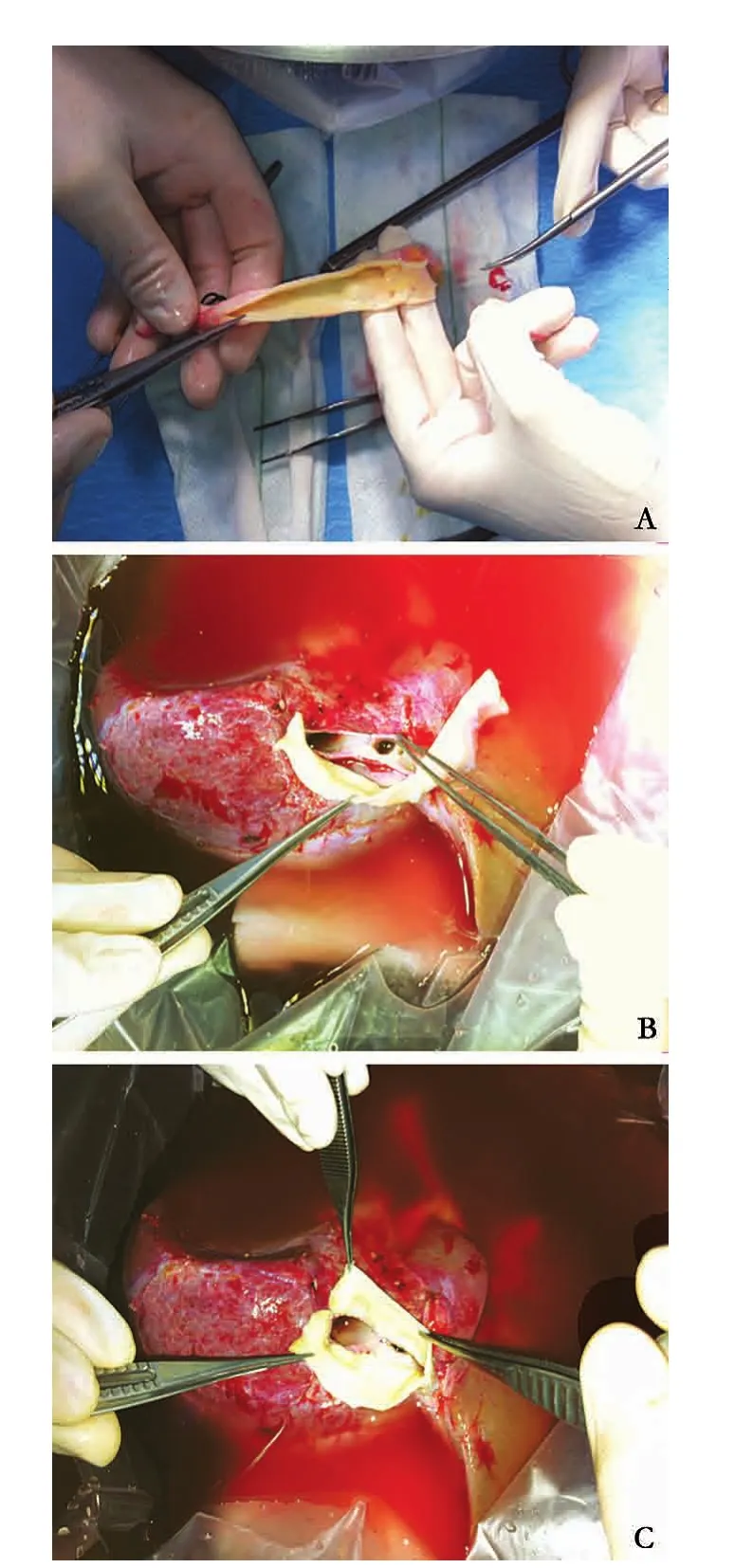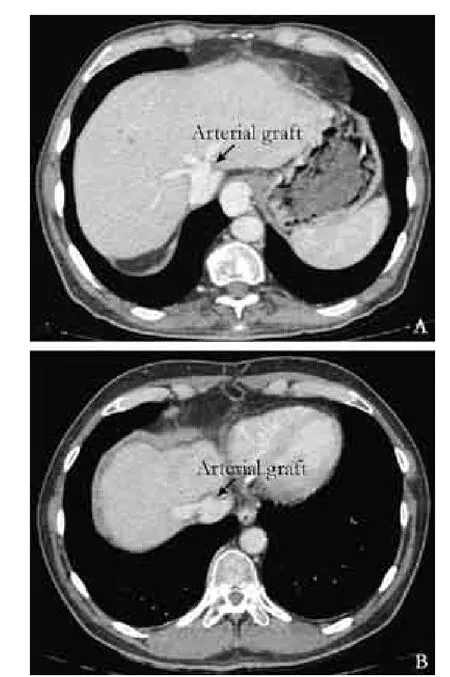Out flow reconstruction with arterial patch in domino liver transplantation:a new technical option
2014-06-11
Barcelona,Spain
Introduction
Domino or sequential liver transplantation (LT)is a widely used technique.Since its description in 1997,[1]the global safety of the procedure has already been established.[2-5]Nowadays,several techniques are used to improve the outcomes.One of the main difficulties of this type of LT arises from the necessity to share the vascular pedicles between the graft and the domino donor.The imperative to obtain a correct vein out flow has led many centers to perform domino LT by using the classical technique.However,the piggy-back technique may have some hemodynamic advantages.These advantages are even more important in patients with familial amyloidotic polyneuropathy(FAP) who have a special hemodynamic liability.Indeed,we should remember that FAP patients are not cirrhotic and do not have portal hypertension.Therefore,in this setting we consider the piggy-back technique associated with temporary portacaval shunt the best technical option.When using piggy-back technique,the obtained domino graft has short hepatic veins.In order to obtain longer hepatic veins,it has been proposed the section of pericardium to lengthen the vena cava stumps.[6]However,this procedure is associated with possible serious complications,and indeed it may not achieve enough caval stump.An alternative to overcome this issue is the completion of hepatic vein reconstruction during bench surgery.Different technical options have been proposed in the literature with good results.[7-12]
The concern in venous reconstruction resides in the imperative to obtain a correct out flow in order to preserve hepatic function and avoid postoperative Budd-Chiari syndrome,which occurs in 2%-8% of liver transplanted patients.
In 2002,a Portuguese group described for the first time the possibility to perform domino LT with piggyback technique and venous out flow reconstruction by using a caval-common iliac bifurcation graft.[7]After this first description,several groups have reported their experience with this type of graft;[7-10]others have proposed similar technical options by using the portal vein[11]or a reopened obliterated umbilical vein.[12]
Our group performed in 1997 the first domino LT in Spain.[13]Since then 36 domino LTs have been performed at our institution.The first 24 patients were transplanted with the classical technique,but in the last 12 we have used the piggy-back technique.Different out flow reconstructions have been employed.
Herein we describe the possibility to use an arterial cadaveric graft to be interposed between the hepatic veins stumps in order to reconstruct the out flow in the domino graft.

Fig.1.Backtable reconstruction.A:opening of the iliac artery to obtain the graft; B:the three hepatic veins are joined together to obtain a single stump,and the long arterial graft is placed upon the single venous stump; C:a long drainage stump of the domino graft.
Surgical technique
A 42-year-old woman diagnosed with FAP agreed to donate her liver.Hepatectomy in the FAP patient was performed using the piggy-back technique.The procedure was uneventful,and veno-venous bypass was not required.
The FAP liver was used as a domino graft.It was perfused on the backtable,through the portal vein and hepatic artery.The bile duct was flushed as usually.No attempts were made to lengthen the hepatic stump in the domino liver; thus the hepatic vein stumps were short.
At the backtable,the three hepatic veins orifices were joined together to obtain a single stump.Then,two cadaveric iliac arteries were employed as an interposed graft to reconstruct the hepatic veins of the domino graft.The two iliac arteries were opened longitudinally(Fig.1A),and sutured to obtain a large arterial graft.This graft was placed upon the single venous stump (Fig.1B),and sutured with an everting 6/0 polypropylene suture.This procedure was allowed to obtain a large drainage conduit of the domino graft (Fig.1C).

Fig.2.Images of the computed tomography (A) one month after LT,showing the patency of the arterial graft upon the hepatic veins stump; and (B) 24 months after LT,showing the patency of the arterial graft upon the hepatic veins stump.
The recipient of the domino graft was a 54-yearold patient who underwent retransplantation for ischemic cholangitis and who agreed to accept the FAP liver.The procedure was also performed with the piggy-back technique.The reconstructed hepatic venous cuff was sutured to the junction of all 3 hepatic veins of the recipient.The portal vein,artery and biliary anastomosis were performed in the standard fashion.The postoperative course of the FAP patient was characterized by a low-volume biliary leakage,which solved spontaneously 10 days later and did not cause any change in patients' clinical management.The postoperative course of the domino recipient was uneventful.
The recipient had no complications,except for selflimited postoperative ascites.All anastomosis were confirmed to be patent with two ultrasonographies before discharge,and a computed tomography performed one month after LT (Fig.2A).After 24 months of followup,the patient is alive with normal hepatic function;vascular anastomosis is patent with normal hepatic vein,arterial and portal flows,confirmed by every 6 months Doppler ultrasonographies and actual computed tomography (Fig.2B).
Discussion
As stated by Tzakis et al,[14]it is important to "play domino" and not to lose these good grafts.But we have tofind the safest way to "play domino".[14]The piggyback technique in domino LT has been proved a safe technique.[2-6,15]To avoid some of the pitfalls of domino transplantation,several technical options have been described.[3]As far as we know,all previously described techniques have used different types of venous grafts.[6-12]
In cardiac and vascular surgery,some authors have shown that arterial conduits typically maintain patency at higher rates than venous conduits.There are no specific studies comparing the results of the arterial and venous grafts used for venous reconstruction in LT,and our group is working in thisfield.Previous papers on living donor LT have described the use of iliac artery grafts for venous out flow reconstruction.[16]To the best of our knowledge the use of arterial grafts for venous out flow reconstruction has never been published in the setting of domino LT.
In our opinion,the arterial graft is another option and may have some advantages compared to the previously described techniques.Firstly,it is always feasible to obtain an arterial graft,either aortic or iliac from the deceased donor for the FAP patient.As described by Pinheiro et al,[10]grafts may be obtained from another cadaveric donor.Secondly,it is easy to obtain a large graft by using both iliac arteries,as described herein.This will allow joining the graft as long as needed upon the single venous stump.Finally,because of the consistency of the arterial graft,we feel more confident about the vascular patency of this type of reconstruction compared to the venous grafts.
In conclusion,the use of arterial grafts for venous out flow reconstruction in domino LT can be safely performed and should be added to the already available techniques.Further studies are needed to compare this new technique with venous reconstruction.
Contributors:RE proposed the study.LL and DLS performed research and wrote the first draft.All authors contributed to the design and review of the study and to further drafts.LL is the guarantor.
Funding:None.
Ethical approval:Not needed.
Competing interest:No benefits in any form have been received or will be received from a commercial party related directly or indirectly to the subject of this article.
1 Hesse UJ,Troisi R,Mortier E,Decruyenaere J,de Hemptinne B.Sequential orthotopic liver transplantation--domino transplantation.Chirurg 1997;68:1011-1013.
2 Ericzon BG,Larsson M,Herlenius G,Wilczek HE; Familial Amyloidotic Polyneuropathy World Transplant Registry.Report from the Familial Amyloidotic Polyneuropathy World Transplant Registry (FAPWTR) and the Domino Liver Transplant Registry (DLTR).Amyloid 2003;10:67-76.
3 Asonuma K,Ohya Y,Isono K,Takeichi T,Yamamoto H,Lee KJ,et al.Current state of domino transplantation in Japan in terms of surgical procedures and de novo amyloid neuropathy.Amyloid 2012;19:75-77.
4 Azoulay D,Salloum C,Samuel D,Planté-Bordeneuve V.Operative risks of domino liver transplantation for the FAP liver donor and the FAP liver recipient.Amyloid 2012;19:73-74.
5 Kitchens WH.Domino liver transplantation:indications,techniques,and outcomes.Transplant Rev (Orlando) 2011;25:167-177.
6 Furtado AJ.Domino liver transplantation using FAP grafts.HUC experience--hopes and realities.Amyloid 2003;10:84-87.
7 Pena JR,Barroso E,Martins A,Andrade JR,Pererira JP.Sequential whole liver transplant resected as piggy-back from FAP patient (abstract).Liver Transpl 2002;8:C24.
8 Jabbour N,Gagandeep S,Genyk Y,Selby R,Mateo R.Caval preservation with reconstruction of the hepatic veins using caval-common iliac bifurcation graft for domino liver transplantation.Liver Transpl 2006;12:324-325.
9 Liu C,Loong CC,Hsia CY,Tsou MY,Tsai HL,Wei CF.Venoplasty of hepatic venous out flow with a venous patch in domino liver transplantation.Liver Transpl 2008;14:1378-1379.
10 Pinheiro RS,Lai Q,Dahrenmoller C,Lerut J.Complex hepatic out flow reconstruction in domino liver transplantation.Hepatobiliary Pancreat Dis Int 2014;13:98-100.
11 Cerqueira A,Pacheco-Moreira L,Enne M,Alves J,Amil R,Balbi E,et al.Out flow reconstruction in domino liver transplantation with interposition of autologous portal vein graft.A new technical option in living donor domino liver transplant scenario.Liver Transpl 2006;12:1298-1300.
12 Mergental H,Gouw AS,Slooff MJ,de Jong KP.Venous out flow reconstruction with surgically reopened obliterated umbilical vein in domino liver transplantation.Liver Transpl 2007;13:769-772.
13 Figueras J,Munar-Qués M,Parés D,Torras J,Fabregat J,Rafecas A,et al.Sequential liver transplantation:description of the first three patients in Spain.Med Clin (Barc) 2001;116:377-379.
14 Tzakis AG.Let's play dominos.Liver Transpl 2000;6:506-508.
15 Figueras J,Parés D,Munar-Qués M,Rafecas A,Casanovas-Taltavull T,Fabregat J,et al.Domino or sequential liver transplantation.Is it a feasible technique? Gastroenterol Hepatol 2002;25:225-229.
16 Hwang S,Lee SG,Ahn CS,Park KM,Kim KH,Moon DB,et al.Cryopreserved iliac artery is indispensable interposition graft material for middle hepatic vein reconstruction of right liver grafts.Liver Transpl 2005;11:644-649.
杂志排行
Hepatobiliary & Pancreatic Diseases International的其它文章
- Laparoscopic distal pancreatectomy in Italy:a systematic review and meta-analysis
- Long-term results of liver transplantation for over 60 years old patients with hepatitis B virus-related end-stage liver disease
- Efficacy of ursodeoxycholic acid as an adjuvant treatment to prevent acute cellular rejection after liver transplantation:a meta-analysis of randomized controlled trials
- Post-pancreaticoduodenectomy hemorrhage:risk factors,managements and outcomes
- Th1 cytokine-based immunotherapy for cancer
- Laparoscopic liver resection under hemihepatic vascular in flow occlusion using the lowering of hilar plate approach
